A Quick Look at Different Types of Plumbing Pipes
2021.02.20
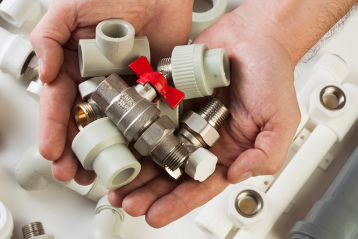
Hand holding plumbing parts and fixtures.
Long gone are the days where clay pipes were used to supply water. What started with the Greek civilization’s drainage system has progressed to include multiple pipe options, each best suited for different parts of your home’s vent and drain system.
Pipes are used in your home for various reasons. Drainage, water supply, and sewage disposal, are just some of the many uses. So, do you use the same pipe for each function, or do separate pipes work better? To answer this question, it's best to first understand the different types of pipes available in the market for your home's plumbing!
Polyethylene Cross-Linked Pipe (PEX)
Most Common Use: Water Supply
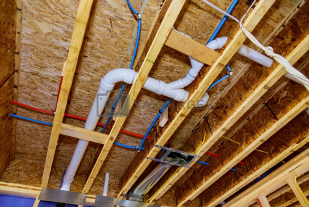
Color coded PEX piping on the ceiling.
Polyethylene cross-linked pipe (PEX) is the newest and most popular choice of pipe used in residential homes. Although usage is limited (only used for supplying water), the many features it boasts has made it a go-to choice for plumbers.
Due to its flexibility, PEX is incredibly easy to install. Its malleable quality means that you can cut it easily and weave it through walls and crawlspaces within a home.
They're also color-coded (red for hot water and blue for cool water), making for more organized plumbing installations. Plus, they’re strong enough to withstand high water pressure!
While they can be installed by homeowners as well, most rely on professional installations due to the special crimping tool needed for more permanent PEX pipe fixtures. It’s also considerably more expensive than traditional plastic or copper pipes. Still, they remain a popular choice due to the low long-term maintenance costs.
Plastic Piping
Most Common Use: Vent, Waste, and Drain Pipes
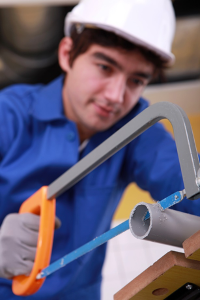
Plumber cutting a PVC pipe with a saw.
If you're a homeowner on a tight budget, then plastic piping may be your best option. It’s affordable and easier to work with than steel or copper piping, which is one of the main reasons it has gained such high popularity.
Although polyvinyl-chloride (PVC) plastic piping is the most common in the plumbing business, there is actually another plastic piping that’s widely used as well! Acrylonitrile-butadiene-styrene, also known as ABS, is a black pipe that was the first of its kind to be used in residential plumbing. However, due to the imminent threat of ABS piping joints coming loose, many residential construction sites forbid the use of the pipe. To know whether your home is eligible, it would be best to ask a professional plumber.
Unlike ABS, PVC pipes are more welcome in the construction world. PVC pipes are a white or light cream color and the most common and widely used option for drainage.
These pipes are unable to withstand high pressure and high-temperature. So, while they may fare really well for your toilet or sink's drain line, they won't perform as well for your shower pipeline due to the high pressure and hot water you might need!
PVC is considerably easy to install and has a long lifeline as well. However, proper installation is critical, since PVC pipes need to be cut, and poorly glued pipes are at a higher risk of leaking and causing damage.
Copper Pipe
Most Common Use: Water Supply Line
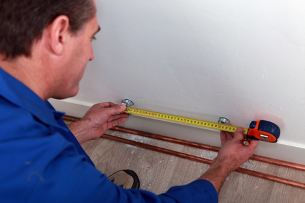
Plumber measuring copper pipes.
One of the oldest pipe materials out there, you can find copper in older homes, but due to the many advantages it has, they’re being installed in new homes as well. And although they’re more expensive than plastic pipes, they’re also known for lasting much longer!
Copper is known for being resistant to corrosion, which is why it’s the ideal pipe choice for water supply lines. The anti-corrosion properties mean that the metal will not affect the water quality or taste over time and is less prone to needing to be replaced. However, when you go to buy copper piping, you'll be asked to choose between rigid copper piping and flexible copper piping. Here's the difference:
Rigid Copper Piping: Rigid copper is the most popular of the two piping options and is available in three thicknesses. For home plumbing, Type M is the ideal option. It's the thinnest of the three options.
Type K and Type L are the thicker piping options and are best suited for any outdoor plumbing. Installation of rigid copper may also be tricky since a hacksaw or tube cutter is required to cut the piping. The soldered connections are difficult to maneuver for amateurs, and since the piping is considerably expensive, it’s not the best do-it-yourself project.
Flexible Copper Piping: Flexible copper is used for small-scale piping needs. This piping option is ideal for dishwashers and other smaller appliances that might need a water supply. Due to their flexible nature, they're much easier to bend, but if the pipe kinks, you have to dispose of the piece entirely and replace it, making it quite a gamble for homeowners.
Galvanized Pipe
Most Common Use: Drain Lines and Water Supply
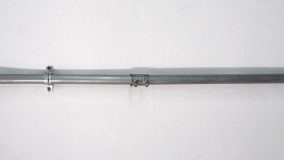
Old silver steel pipe.
While galvanized piping is old news and no longer installed in current construction projects, it can still be found in any old home you come across. Galvanized pipes were the first non-lead alternative back in the day, which is why most older homes use them for their plumbing systems.
Although it’s true that galvanized piping is a strong option, it also has a limited lifespan. In 50 years’ time, the material has a tendency to rust and need replacement. If you’re considering repairing old steel pipes, it might be best to replace them entirely with modern options that work better. For the best replacement options, discuss with a professional plumber.
About The Author
The author is a regular contributor to the blog and has been working in the plumbing industry for the past decade! They are currently employed with Pro Serve Plumbing.
Pro Serve Plumbing is a Fort Worth, Texas-based plumbing service that provides its services to residential and commercial homes. Contact them for all plumbing based emergencies, including tankless heater repair and gas line installations!
More Articles
Copyright © Fooyoh.com All rights reserved.